Hello and welcome!
Saturday, I had the joy of celebrating the baptism of Rafael Heyne, who is the son of Drs. Tom and Nancy Heyne. I presided at their marriage and baptized their first child, so it was wonderful to be able to also baptize little Rafael.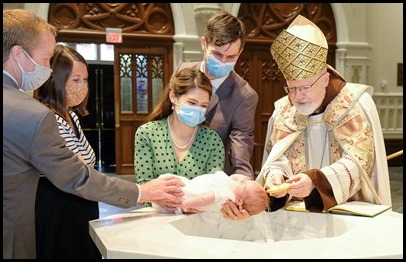
I always enjoy the opportunity to be able to celebrate these special moments with families.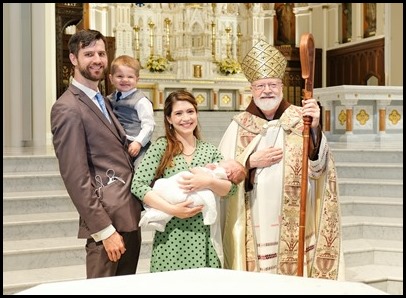
Sunday, I was happy to join Ascension Parish in Sudbury for their Mother’s Day morning Mass at Our Lady of Fatima Church. The readings of the day centered on love, so it was a beautiful theme for Mother’s Day.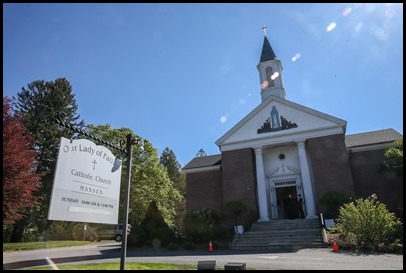
The pastor, Father Gerald Souza, is doing a wonderful job there. He noted that it had been 16 or 17 years since I sent him to the seminary, and he thanked me for my patience. I said that it just goes to show that you have to treat the seminarians very well because, one day, they’ll be your pastors!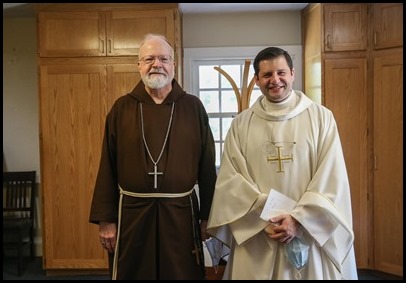
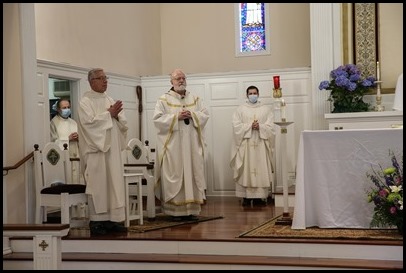
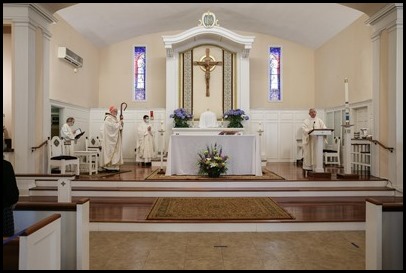
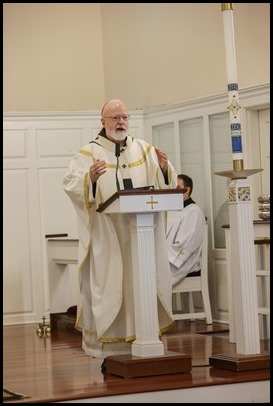
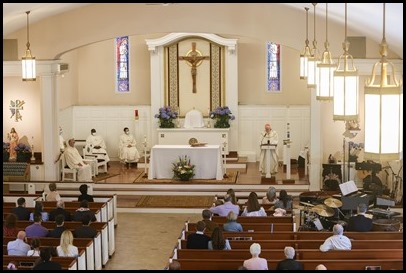
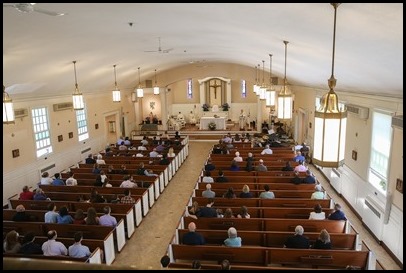
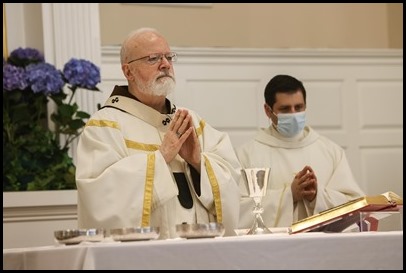
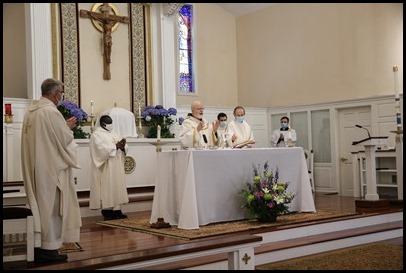
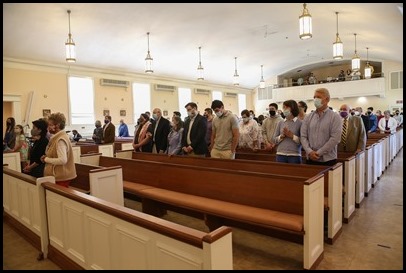
We had lovely weather that day, so I was able to be outside and greet the people after the Mass. It was nice to greet and congratulate all the mothers on their special day.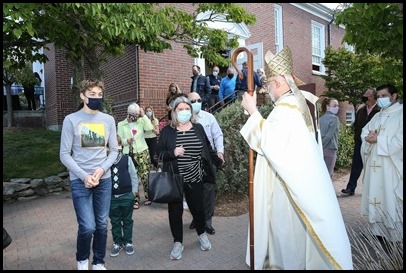
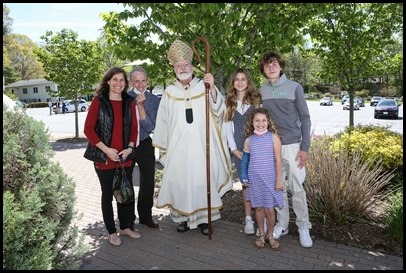
On Monday, I traveled to Washington, D.C. to celebrate the Baccalaureate Mass for the Pontifical John Paul II Institute, which was held the next day. It’s been a year since I’ve been in Washington, and it was a great joy to be able to stay with the Capuchin community there.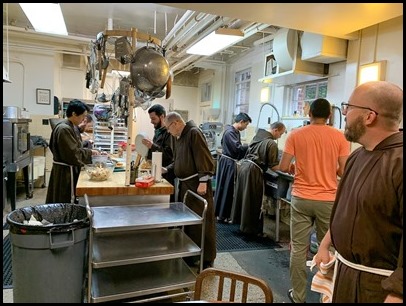
I was happy to see they have a new resident – Padre Pio!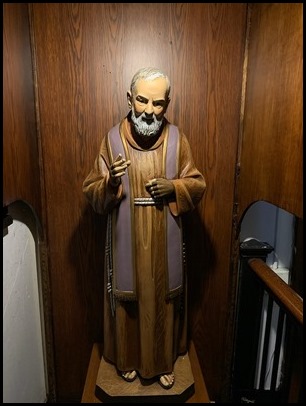
It’s always wonderful to be with the friars and enjoy their fraternity and the good example that they always give.
The Baccalaureate Mass on Tuesday was supposed to have been held at the John Paul II National Shrine, but because of pandemic restrictions, we held it at St. Bernadette’s Parish in Silver Spring, Maryland.
There were about 30 concelebrating priests and a large congregation, including about 30 graduates representing the class of 2021 as well as the class of 2020, because they weren’t able to have a commencement ceremony last year.
In my homily, I spoke a little bit about how I was present in Washington at the time when then-Fathers Carlo Caffarra and Angelo Scola were working with Father Lorenzo Albacete and Carl Anderson to establish the Institute. I’d like to share that homily with you here:
I am very honored to have been invited to celebrate this Baccalaureate Mass for the graduates of the John Paul II Institute.
I see that Netflix has just done a docudrama of the heist at the Isabella Stewart Gardner Museum in Boston. If they ever decide to do a docudrama on the John Paul II Institute, I would aspire to a walk-on part, a supporting role, in the prequel. I have so many fond memories of the 1970s-1980s, of the then Msgr. Caffarra visiting Washington and working with Father Lorenzo Albacete to make a reality the dream of St. John Paul II. We would often dine at the Sizzler or some other fast-food emporium. Invariably, the kitchen staff were all my parishioners from the Capilla Latina, and Lorenzo would mock me roundly for my celebrity status because of all of the attention we garnered from my pious parishioners.
It was in those days, too, that I came to know Carl Anderson and the then Father Angelo Scola, and other extraordinary individuals who were so dedicated to the vision of John Paul II and made such outstanding contributions to this Olympus of Christian anthropology and theology.
John Paul II’s contributions to the spirituality and theology and his profound understanding of marriage are a sacred legacy of this institution which is today sending out its graduates with a great sense of mission and purpose.
It was in 1979, as a young priest working with immigrants here in Washington, that I was asked by Cardinal Baum to go to the Puebla Conference in Mexico to be a secretary and translator for Archbishop Quinn and Bishop Kelly, who were representing the USCCB. It was an opportunity to be there for John Paul’s first Apostolic Visit as Pope.
They say that the number of miles he traveled during his pontificate was equivalent to traveling to the moon three times. What a thrill it was for a young priest to be a part of his first trip. When the Pope’s plane touched down in Mexico, all the churches’ bells in the country rang out. The young Pope climbed into an open car and drove 80 miles from Mexico City to Puebla. The crowd extended the whole way. Many had slept on the highway to be there when the Holy Father passed, much like the people in the Acts of the Apostles who laid the sick by the side of the road so that Peter’s shadow might touch them.
When he arrived in Puebla, the Holy Father got out of the car, walked across the soccer field, vested for Mass and celebrated the Eucharist for us. I shall never forget his homily in which he challenged us to be teachers of the truth: the truth about Christ, the second person of the Blessed Trinity, true God and true man, our Savior and Redeemer; the truth about the Church founded by Jesus Christ and the Apostles; and the truth about the human person, made in the image and likeness of God, created by God’s love and destined to live forever in God.
Obviously, in today’s world, it is the third truth that is the most challenged by our secular culture. That is why John Paul II was so anxious to have an Institute such as this to be an effective instrument of formation and evangelization. The Holy Father had planned to announce the establishment of this Institute at the Wednesday Audience of May 13, 1981. The powers of darkness never sleep, and a shot was fired that could have saved world communism and prevented the establishment of this Institute, but Our Lady of Fatima wanted that bullet to be placed in her crown; and so she interceded to rescue her Pope whose motto was borrowed from St. Louis Marie de Montfort: “Totus Tuus.”
One of the great marvels of the Easter season is listening to the lessons read at Mass from the Acts of the Apostles, that Gospel of the Spirit where St. Luke traces out for us the beginnings of the Church, the community of faith. Reading today’s passage reminds me of my first sermon, which I gave in a prison. I had been inspired to talk about great escapes in the Bible: Daniel in the lion’s den, the three lads in the fiery furnace, Paul escaping over the walls of Damascus in the laundry basket, and so forth. I had the rapt attention of my audience, but that night six prisoners escaped, and I feared my first sermon was going to be my last.
Obviously, my sermon did not include today’s reading, which is only a near escape. Paul and Silas had the opportunity, but they chose not to flee. The mob at Philippi had attacked them; the magistrates had them stripped and beaten with rods and thrown into prison, putting them in the innermost cell and securing their feet to a stake.
A couple of years ago, after the earthquake in Haiti, I visited one of the camps set up by CRS near Port-au-Prince, where there were 350,000 people living in tents. I will never forget how, in the middle of the night, you could hear the people singing and praising God. I was so moved by their faith in the midst of their suffering and desperation. Today’s reading says that about midnight Paul and Silas were praying and singing hymns to God as the prisoners listened.
I wonder if St. Paul could sing well. They once asked Pope St. John Paul II if he could sing. Quoting St. Augustine, who said that “singing is praying twice,” the Holy Father said: “When I sang, it was more like praying once.”
I have not experienced a serious earthquake firsthand. However, once when I was bishop in the West Indies preparing for an ordination, we experienced very strong tremors in our cathedral that were accompanied by a roaring sound as if a train were passing through the building. The young man who was to be ordained was quite shaken up and wondered if God was trying to tell him something. Obviously, we wasted no time in dashing out of the cathedral into the streets where it took me a few minutes to convince the candidate that it was all right to go back into the Church and be ordained.
It is remarkable that Paul and Silas did not rush out of the prison to escape both the earthquake and their cruel captivity. I’m sure I would’ve felt that if my singing had provoked an earthquake, I would be entitled to a “get out of jail free card.”
Paul realized that the jailer was about to fall on his sword and called out to reassure him: “Do not harm yourself; we are all here.” Suddenly the jailer is able to formulate the burning question in his heart that undoubtedly was there as he listened to the singing and the prayers in the darkness. Paul and the believers could have abandoned him to die, but they showed him the courage and generosity born of their faith and their desire to witness that faith to others. “Sirs, what must I do to be saved?” And they said, “Believe in the Lord Jesus, and you and your household will be saved.” The captor, the enemy, is transformed into a disciple, a brother. He and his family were baptized at once. He brought them up to his house and provided the meal, and with his household rejoiced at having come to faith in God.
Sometimes we may feel very frustrated in our attempts to evangelize. It is like singing in the darkness and wondering if anyone is listening. Our duty and our privilege is to keep on singing. Somewhere, someone is listening, and God is touching their hearts.
The language invoked around graduations contains the expressions “baccalaureate” and “commencement.” The baccalaureate is described as a farewell prayer service, and commencement, of course, conjures up a sense of being launched into one’s new life, having prepared oneself and graduated to begin a new job, new vocation and, hopefully, a new mission.
The Gospel passage from today’s Mass is Jesus’s baccalaureate address at the Last Supper, where the Lord is preparing his disciples for what comes next. Actually, in the New Testament, there are two farewell ceremonies; they both happen to be on a Thursday: Holy Thursday and Ascension Thursday. Paradoxically, on both of these solemn occasions, Jesus is saying farewell and at the same time assuring us that he will be with us always.
At the Last Supper, Jesus gives us a command, a gift and a promise. To get our attention, he washes the feet of his disciples. Pope Francis, by performing this service in the prisons, has rescued the foot washing from being solely a liturgical ceremony. This radical gesture of humble service is accompanied by the New Commandment that we who are Jesus’s disciples love each other the way that Jesus loves us. He loved us first while we were still in sin or indifferent to his love. He loves us to the extreme; he loves us to the point of laying down his life for his friends. The sobering thought is that his love for us is the measuring stick that we must have for our brothers and sisters in the household of the faith. It goes beyond loving one’s neighbor as oneself. Our identification card is the mutual love and fraternity that characterizes our community. We must learn to love first, to forgive first, to love as Jesus does, laying down his life for his friends.
Having given us this command, the Lord makes a gift of himself to us in the Eucharist. Even as he says farewell, he promises to be present in this gift of himself. And he tells us that it is better for us that he go so that he will be able to send the Advocate, the Spirit, to guide us.
On Ascension Thursday, the second farewell, Jesus once again gives us a command: “Go make disciples of all nations, teaching them what I have taught you and baptizing them in the name of the Father and of the Son and of the Holy Spirit.” We are here today because that group of followers received that command and went to the ends of the earth, laying down their lives to witness to the faith and to make disciples. The Church exists to evangelize. Today it’s our turn. Once again, Jesus’s farewell is accompanied by a promise that he will be with us always and that his Spirit will guide his Church.
As I have mentioned, the Acts of the Apostles, for me, is such a special book. Studying it in the seminary, I was impressed by the elegance of St. Luke’s Greek, which made it all the more puzzling to see how the book ends. Rather than following all the literary norms of the times and giving a proper ending, the book seems truncated. One of the theories is that St. Luke had a falling out with his agent, or perhaps he died before he could finish the manuscript. I like to think that the Acts of the Apostles was not meant to end; it goes on and on as the Spirit guides our Church and helps us struggling disciples to continue on the mission that Christ has entrusted to us. We are now the protagonists of this “Gospel of the Spirit.”
Today, as we reflect on the powerful messages in the words and gestures that Jesus incorporates in his farewell baccalaureates of Holy Thursday and Ascension Thursday, we pray in this Eucharist that your graduation, your preparation here, will give rise to a commencement, a new beginning, a recommitment to the Church’s mission and to your own personal vocation.
Msgr. Albacete, in his latest book: “The Relevance of the Stars,” speaks eloquently about the new evangelization as a retrieval of the foundational Christian experience of the person of Jesus Christ as the incarnate destiny of each human being.
He writes: “Nowhere is the modern age’s radical inability to create or even understand how human beings are to live together clearer than in its inability to promote and sustain the family, the fundamental community of human life. We are facing efforts to radically redefine the family to make it fit the impoverished anthropology characteristic of modernity. In the most recent generations of Catholics, we are seeing a tragic loss of the experience of authentic family life. That is why the bishops of Latin America and the Caribbean, echoing the pastoral agenda of Pope John Paul II, have called the family the ‘frontier’ of the New Evangelization.”
You, graduates of the Pope John Paul II Institute, must become the defenders and promoters of the family, this frontier of the new evangelization.
The Church desperately needs a new apologetic directed at the real questions that modern people have. In the past, we used the Baltimore Catechism as a response to many of the questions that American Protestants raised about the teachings of the Catholic Church. That apologetic helps many Catholics to understand the faith and feel comfortable in their beliefs.
It was the same apologetic that Patrick Madrid of Catholic Answers provided when I was bishop in St. Thomas and invited the Catholics and Seventh Day Adventists to come together in my cathedral to respond to the Adventists’ attacks on Catholic doctrine. I did not sleep the night before, I was so worried about the outcome, and I even removed the Blessed Sacrament from the cathedral for fear of desecration. Patrick Madrid, with great serenity and eloquence, presented the Biblical faith of the Catholic Church. Some of the Adventists, as they left the cathedral afterward, approached me to ask how they could join the Catholic Church. It truly was an unforgettable experience.
However, in today’s world of secular humanism and religious indifference, a new apologetic is needed. One such attempt was made by Catholic Voices and their team to prepare Britain for the visit of Pope Benedict XVI. Their approach was one of shedding light and not heat, about reframing the arguments so hearts can be opened and minds can be inspired. One of the outcomes of their initiative was the book “Defend the Faith Without Raising Your Voice.”
We desperately need a new apologetic that will allow us to dialogue with the modern world. However, the new apologetic will be successful only if the apologists are witnesses of authenticity and holiness.
The culture wars won’t do it. We do not win because the jailer falls on his sword. We want to baptize him. Pope John Paul II, in his message to artists, quotes from Dostoyevsky: “Beauty will save the world.” I would add to that a word from Pope Francis’ Evangelii Gaudium: “The world does not need prophets of doom but needs to see us living the challenging demands of the Gospel with joy.”
Beauty and joy will save the world. Our prayer for all of you is that you will live a beautiful Catholic life and that, in the midst of the crosses, suffering and setbacks, you will know the joy of the Gospel and be able to sing in the darkness, as St. Paul did. Then you will defend the frontier of the new evangelization, and you will baptize the jailer because he will know that you care about him.
The Knights of Columbus have a special relationship with the John Paul II Institute. So, with us for the Mass was Supreme Knight Patrick Kelly.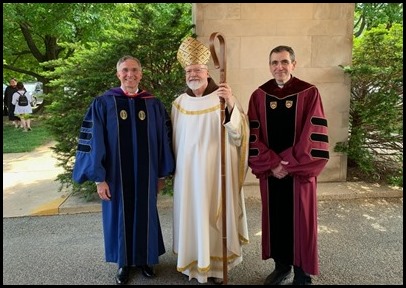
With Supreme Knight Kelly and Provost/Dean Father Antonio Lopez
The Supreme Knight presented me with this beautiful relic of Blessed Father McGivney.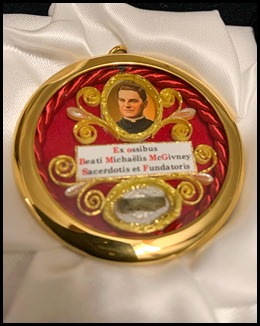
I mentioned to Supreme Knight Kelly how beautiful the beatification ceremony for Father Solanus Casey was and that I am sure the ceremony for Blessed Father McGivney would have been just as grand if the Knights of Columbus could have come together for the celebration.
I am looking forward to the time when we can have a celebration at the Cathedral of the Holy Cross for our local Knights of Columbus and their families to celebrate Father McGivney’s beatification. Of course, now, we will be able to have this beautiful relic of Father McGivney with us for that event.
I returned to Boston on Wednesday and, that evening, I went to Our Lady of the Assumption Parish in East Boston to bless a beautiful new icon that they have had painted in their lower chapel.![]()
They began the project more than a year ago, but it was interrupted when the pandemic hit last spring, and they have only recently been able to complete it. It depicts the Dormition of Mary, which is a tradition in the Eastern Churches celebrating Mary’s “falling asleep” in death surrounded by the Apostles before her Assumption into heaven.![]()
![]()
![]()
With us for the occasion was the artist from Spain who painted the icon, David Lopez. After the blessing, he gave us a talk about some of the symbolism of the icon and of the spirituality of iconography.![]()
![]()
With David and his wife, Beatriz
On Thursday, I visited Cathedral High School, which was celebrating their seniors during their final week of classes. I visited with the seniors and, afterward, greeted some of the other students in their classrooms.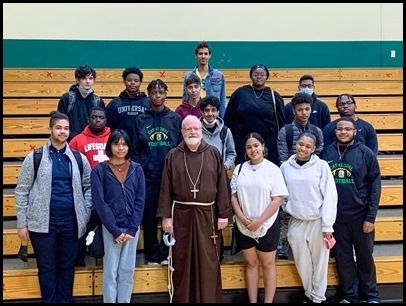
We are so proud of the work that they are doing at Cathedral High, particularly over this past year which has presented so many challenges. I was happy to have the opportunity to congratulate the seniors on their great accomplishment.
Thursday afternoon, I took part in a Zoom meeting that was part of the ongoing follow-up to the V Encuentro. One bishop from each of the U.S. regions of was invited to participate, and I represented Region I.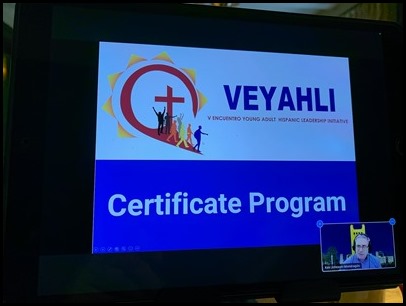
They were seeking the input of the bishops on some of the programs they are considering to promote lay ministry in the Hispanic community, particularly among young adults.
Finally, yesterday evening, I went to celebrate the Feast of the Ascension with the Sister Disciples of the Divine Master at their house on West Street.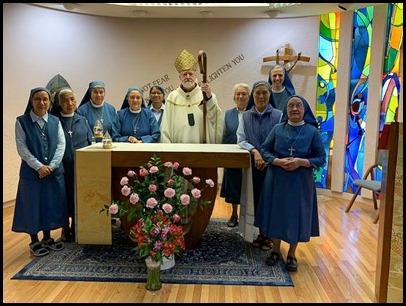
It was wonderful to be with the sisters to celebrate this important feast, which begins the Novena of Pentecost.
Until next week,
Cardinal Seán
